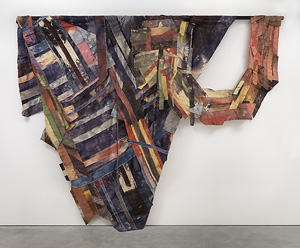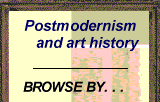Stepping Out
John Haberin New York City
Pass, Carry, Hold: Studio Museum Artists in Residence
Leonardo Drew and Al Loving
In stepping off the wall, can art trace the materials of a life? This year's Studio Museum in Harlem artists in residence, on display at MoMA PS1, give it a try.
Late Modernism taught a generation to see painting as drawing in space and art as object, which sounds just the thing for going off the way. It might be all about the artist or you. But it had an unanticipated result: now anything goes, anywhere between the ceiling and the floor. New York galleries give material shape to a career. That can mean no direction at all and lousy art, but it works for the three Studio Museum artists—and it works with a typically enormous mess by Leonardo Drew and now Al Loving. Drew covers an entire Chelsea gallery while gathering light, while Loving keeps taking paint on canvas into the room. 
Psst, pass it on
A program of artists in residence is a good deal all around. Young artists in need of a break get a free studio, the imprimatur of a museum, and a show at year's end. The rest of us get an insider's view of artists at work. Whatever are they doing in all that time, and what emerges day by day? You find out—which is not to say that I can handle another open-studio weekend, long past the heady days of Williamsburg, Bushwick, and Dumbo, with no one to screen the artists but those who attend. But this program belongs to the Studio Museum, still closed for expansion and renovation and still worthy of respect.
"Pass Carry Hold" sounds modest enough from its title (psst, pass it on), and it looks modest enough, too. The three African American artists get adjacent quarters along the hall, rather than dividing one of the museum's spacious wings like last year or the year before. It could well replicate the layout of their studios uptown, only smaller. Why the modesty? You might expect the three to spend the year amassing a body of work and a profile as an artist. Instead, each has nurtured a single work as it comes to be.
At least it seems so. Malcolm Peacock divides his space with a black curtain, like a theater, and his comedy or drama stars family and friends. Their indecipherable voices fill the air around just one object behind the curtain, in the shape of a giant redwood. A tree like that lives a long time, and who knows how much it might grow in the course of a year, but this emerging artist aims for stability. The trunk's warm red comes from hair on a wood frame that seems to twist as it grows, like the twist and turns of a human lifetime. Hairs have sharper colors as well, in highlights of his own devising.
Zoë Pulley starts with family, too, while reaching out. "What," she asks, "is a memory you have with one clothing item from your childhood?" She assembles memories of her own and her parents' childhoods, which is good, because I, for one, could not have come up with a single one. She fashions images of a blouse, a shirt, and a suit into plastic and vinyl, hanging beside a tapestry of seat belts. Apparently the past is more confining than she might wish. And maybe the truly clothes conscious start young.
If Pulley feels constrained, though, she never lets on, and the same items appear in photos of family members with ornate black frames. Their ovals suggest still older fashions, as do memorabilia like a telegram from Western Union. They are separate works, but connected: they recall a wrenching move from Washington to Prince George County—not far, but just far enough to her set her on the course of a life. If an emphasis on clothing translates into gender awareness, the third artist, sonia louise davis, sees her woven work as "feminist abstraction." And she, too, treats it as almost an installation to itself.
These are "soft paintings," in the present-day fashion for a woman's craft as art and weaving as painting. They earn their softness at that, with varieties of wool in a loose, broad weave. She hangs some off the wall so that one can see both sides of a material object, contributing to the sense of an installation. So does a second room for sound art, a simple banging on metal from, she explains, impressions on her daily walks in St. Nicholas Park in Harlem. It rings out like bells beside wall painting that could be anything from living things to a Soviet hammer and sickle. Memories are deceptive and often sentimental, and so it is for all three, but so, too, is the passage from childhood to a career in art.
Stop at nothing
When a work takes over the gallery, is it site specific, or was the gallery an obstacle on the way to making art? For Leonardo Drew, the choices are inseparable. He makes work so massive and diffuse that it stops at nothing—if only as a figure of speech. In real life, Drew stops for everything, only to keep piling it on. The result is untitled, for who would dare pin it down? The walls themselves are a welcome breath of light.
Drew has been piling it on for a long time now. I first encountered him in what become one of this Web site's first gallery tours, in early 1997, and again in 2001. I started the site with extended reviews of art's deep history in museums, where my heart still lies. I had gone to galleries, though, and was just then seeing the departure from Soho in action. One dealer on the move, Mary Boone, had shaken things up on West Broadway with a scorn for late Modernism and a studied elegance, with such artists as Julian Schnabel, Eric Fischl, and David Salle. Drew, though, had little time for either elegance or scorn. He was trashing the place much as late modern art had done before.
 Richard Serra had flung molten lead, at his own risk. Barry Le Va had broken glass, and Chris Burden had crawled across the wreckage. Artists have been sorting through the damage ever since. For Ilit Azoulay at the Jewish Museum, every loss is the bearer of memory in the Middle East. And one can look at Drew's scraps a long time in search of something familiar, from his studio or his history. He is, after all, African American. He, though, has his eye elsewhere.
Richard Serra had flung molten lead, at his own risk. Barry Le Va had broken glass, and Chris Burden had crawled across the wreckage. Artists have been sorting through the damage ever since. For Ilit Azoulay at the Jewish Museum, every loss is the bearer of memory in the Middle East. And one can look at Drew's scraps a long time in search of something familiar, from his studio or his history. He is, after all, African American. He, though, has his eye elsewhere.
Another side of late Modernism nurtured the optical and physical qualities of nonstandard materials. Back when, Drew incorporated rust for its powdery texture and iron oxide glow. Now he combines wood scraps, glass and paint. They produce dark colors against the gallery's freshly painted white. He also arranges them in square panels, hung on the walls much like squares for Ad Reinhardt. He asks to restore Reinhardt's translucency, color, and approach to black while playing to the house.
Still, these are remnants, and he lets you know it. Back in the day, I saw a little too much theater. I compared the air of decay to the end of Planet of the Apes, the Statue of Liberty among the ruins, while less sure about what to curse. Drew can, though, be genuinely site specific, accepting what came before. When he turned to public sculpture in Madison Square Park at the start of the pandemic, he let the grass shine through. It was high time I revisited my own cynicism.
It is hard to dismiss outright work that covers the walls, nestles into a corner, and surrounds supporting columns. Scraps on the wall seem to rise as if from a single act of force, and the corner pile gives that force direction. Scraps on one column gather at top like a mushroom, while scraps on the other fall around the base. They look back to the artist's studio while running free. They are anything but Reinhardt's, but they still play with materials, darkness, color, and light. Theater or not, it is the show's heart of glass.
Paper thin
Al Loving had a light touch. Not that he shied away from deep colors, but brighter curves cross them like particle tracks close to the speed of light. An entire assemblage is in constant motion at that. Arcs and strips of varying width run wild, spinning or jutting outward with little care for their neighbors. But then work from 1978 and 1979, really is light, even on the tremendous scale of a wall. It is, after all, made of paper.
A fine lightness is even more vivid in reproduction, where the painted fields let in white from the page or screen. In the gallery, though, the work gathers weight, as things tend to do in real life. It has the shape of Exotic Birds, aluminum reliefs by Frank Stella from precisely the same years. It has their metallic sheen, too, as paint darkens, accumulates, and reflects the light. It recalls Stella's weighty experiments, going back to shaped canvas, in another way as well, for these are not just works on paper. They are works of paper, and the irregular outlines of the materials are the work.
Unstretched canvas from the early 1970s has the same play of lightness against weight, much as for Sam Gilliam and Richard Tuttle. The fabric hangs down of its own accord, stained with parallel bars. The paper includes grids, too, set at an angle as if seen in perspective. It takes on that much more vibrancy and substance by seeming to come off the wall. Geometry also helps hold the work together, as does the tendency of shapes and colors to collide and merge. Tall, narrow paper constructions approach welded steel from another African American, Melvin Edwards.
Alvin D. Loving, Jr., might have had his own memories of flame cutting through metal. He was born in Detroit, in 1935, although his father taught school and then college rather than worked the assembly line. He studied at the University of Illinois and then the University of Michigan, where the elder Loving served as dean. Geometric abstraction came naturally to him, too, just as to another black artist in Stanley Whitney. Paintings from the early 1970s have the pale yellows, hard edges, and diagonals of Stella from those years as well. They just happen to look like cubes edge-on.
People too often overlook Loving's engagement with his time. Like many black artists, he had to put up with life on the margins almost to his death in 2005. He had a reputation as an Abstract Expressionist after painting had moved on. His very choice of materials helped mark him as a lightweight, as did his sense of irony. He did not stick to the sobriety and rule-based structures of Minimalism, but neither did he have the organic form of Post-Minimalism for Eve Hesse and others. Yet he has their tactile presence, and he called the unstretched canvas Self-Portraits.
Were they portraits of blackness? Not particularly, although they do resemble blankets out of any number of cultural traditions. They also look newly contemporary. Thanks to feminism and art-world fashion, a Neo-Minimalism on fabric keeps coming—as just the past month from Elena del Rivero, Martha Clippinger, Brent Wadden, and Lissy Funk. Loving's unstretched canvas and paper, though, tell only part of the story of a painter with real weight. More of his past is still to come.

Leonardo Drew ran at Galerie Lelong through October 19, 2024. "Pass Carry Hold" ran at MoMA PS1 through February 10, 2025, Adam Winner at Josée Bienvenu through July 11, 2015, Al Loving at Garth Greenan through June 27, Elena del Rivero at Josée Bienvenu through May 23, Martha Clippinger at Hionas through May 30, Brent Wadden at Mitchell-Innes & Nash through May 30, and Lissy Funk at JTT through June 21.




